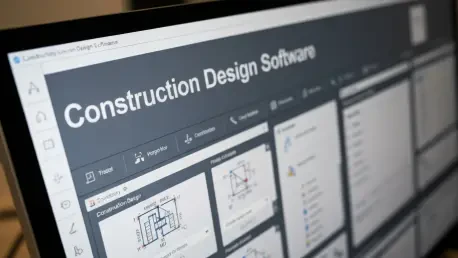Overview of a Transforming Industry
Imagine a world where towering skyscrapers and sprawling smart cities are designed with pinpoint accuracy before a single brick is laid, reducing errors and slashing costs by millions. This is the reality of the construction design software industry in 2025, a cornerstone of the architecture, engineering, and construction (AEC) sector. Valued at billions globally, this market is revolutionizing how projects are conceptualized, managed, and delivered, driven by digital tools that streamline complex workflows.
The significance of these software solutions lies in their ability to bridge the gap between imagination and execution. From 2D drafting to advanced 3D modeling and Building Information Modeling (BIM), they empower professionals to visualize and refine designs with unprecedented detail. Major players like Autodesk Inc., Bentley Systems, and Dassault Systèmes dominate the landscape, pushing innovation and setting benchmarks for efficiency across regions such as North America, Europe, and Asia-Pacific.
Deployment models further shape adoption, with cloud-based platforms gaining traction for their flexibility and real-time collaboration features, while on-premise solutions remain relevant for firms prioritizing data control. As the industry stands at this pivotal moment, the stage is set for even greater transformation, fueled by technological advancements and global demand.
Key Trends and Market Drivers
Emerging Technologies and Industry Shifts
The evolution of construction design software is marked by a seismic shift from traditional Computer-Aided Design (CAD) to comprehensive BIM systems that manage entire project lifecycles. These platforms enable clash detection, cost estimation, and construction sequencing, ensuring smoother operations from design to delivery. This transition is not just a trend but a fundamental change in how the AEC sector approaches complexity.
Beyond BIM, the integration of cutting-edge technologies is redefining possibilities. Artificial intelligence (AI) powers generative design, offering multiple solutions based on specific constraints, while cloud computing facilitates seamless collaboration across global teams. Digital twins, augmented reality (AR), and virtual reality (VR) further enhance capabilities, allowing real-time asset monitoring and immersive design reviews that improve decision-making.
Demand is also driven by evolving industry needs, such as smart city developments, green building initiatives, and modular construction methods. User-friendly interfaces and automation features are making these tools accessible to a broader audience, from large firms to small contractors. This democratization ensures that innovation reaches every corner of the market, amplifying its impact.
Market Growth and Projections
Looking ahead, the construction design software market is poised for robust expansion, with projections estimating growth to US$15.4 billion by 2030, reflecting a compound annual growth rate (CAGR) of 7.7% from 2025 onward. Within this, the core software segment is expected to reach US$10.0 billion by 2030, growing at a striking 9.0% CAGR, highlighting its central role in driving industry progress.
Regionally, disparities and opportunities abound. China’s market is forecasted to surge at a 12.2% CAGR, reaching US$3.3 billion by 2030, fueled by rapid urbanization and infrastructure investments. Meanwhile, the U.S. maintains a strong foothold, with a stable market presence valued at billions in 2025, underpinned by smart city projects and sustainable building trends.
This growth is propelled by dual demand from developed and emerging economies. While mature markets focus on retrofitting and advanced urban planning, developing regions prioritize scalable solutions for large-scale infrastructure. This dynamic creates a global landscape ripe for innovation and investment over the next several years.
Challenges Facing the Industry
Despite its promise, the construction design software sector faces significant hurdles that could temper growth if unaddressed. High initial costs for advanced tools like BIM pose a barrier, particularly for smaller firms with limited budgets. Additionally, the steep learning curve associated with complex systems often deters adoption among traditional users accustomed to simpler methods.
Technological integration presents another challenge, as marrying new software with legacy systems can lead to compatibility issues. Data security in cloud-based platforms remains a concern, with risks of breaches threatening sensitive project information. These technical obstacles require strategic planning to ensure seamless implementation across diverse operational environments.
Market-driven issues compound these difficulties, with varying demand across regions creating uneven growth patterns. Intense competition among software providers also pressures pricing and innovation cycles. Solutions like affordable Software-as-a-Service (SaaS) models and targeted training programs offer pathways to mitigate these barriers, fostering wider accessibility and skill development.
Regulatory Environment and Compliance Impacts
Government policies play a crucial role in shaping the adoption of construction design software, particularly through mandates requiring BIM for public infrastructure projects. Across North America, Europe, and Asia-Pacific, such regulations ensure standardized digital workflows, enhancing transparency and accountability in large-scale developments.
The emphasis on digital documentation and compliance reporting further accelerates software use in both public and private sectors. These requirements compel firms to adopt tools that streamline record-keeping and regulatory adherence, aligning project execution with legal frameworks. This trend underscores the software’s role beyond design, extending into operational governance.
Sustainability regulations add another layer, with green building certifications pushing for features like energy modeling within design platforms. Compliance with data security standards is equally critical, safeguarding collaborative environments where multiple stakeholders access shared information. Together, these regulatory forces mold software functionalities to meet broader societal and environmental goals.
Future Outlook and Innovations
The trajectory of construction design software points toward continued digital transformation, with BIM solidifying its position as the backbone of project management. Its ability to integrate data across phases—from planning to maintenance—positions it as indispensable for tackling the intricacies of modern construction challenges.
Emerging disruptors like AI-driven generative design and widespread use of digital twins for asset monitoring are set to redefine industry standards. These innovations promise not only to enhance creativity but also to provide actionable insights throughout a building’s lifecycle. Their adoption signals a future where precision and foresight dominate project outcomes.
Growth areas are diverse, with emerging markets focusing on infrastructure expansion and developed regions prioritizing smart city frameworks. Global economic conditions, strategic partnerships, and shifting consumer preferences will further influence dynamics, creating a landscape where adaptability and collaboration are key to sustained progress.
Reflecting on Industry Insights
Looking back, the analysis of construction design software revealed a sector that has been on the cusp of unprecedented growth, driven by technological breakthroughs and global needs. The projected climb to a US$15.4 billion market by 2030 underscores a transformative era that has begun to reshape the AEC industry through digital means.
For stakeholders, the path forward involves actionable steps like investing in scalable SaaS solutions to lower entry barriers for smaller players. Fostering collaborations between software developers and construction firms promises integrated workflows that can enhance efficiency. These strategies aim to capitalize on the momentum already built.
Beyond immediate actions, the industry needs to prepare for evolving challenges by prioritizing training initiatives to close skill gaps. Embracing sustainability through software features that support green practices remains vital. These considerations ensure that the sector not only grows but also contributes meaningfully to a more efficient and responsible future.









